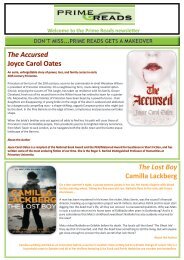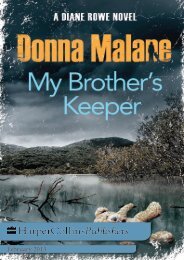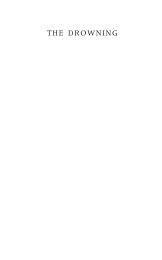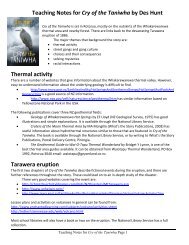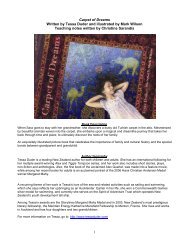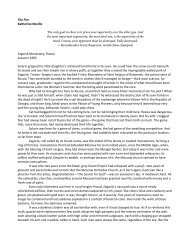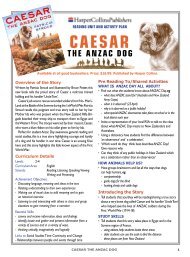Frog Whistle Mine - Harper Collins New Zealand
Frog Whistle Mine - Harper Collins New Zealand
Frog Whistle Mine - Harper Collins New Zealand
You also want an ePaper? Increase the reach of your titles
YUMPU automatically turns print PDFs into web optimized ePapers that Google loves.
Teaching Notes for <strong>Frog</strong> <strong>Whistle</strong> <strong>Mine</strong><br />
The setting for <strong>Frog</strong> <strong>Whistle</strong> <strong>Mine</strong> is Charleston, an old mining town<br />
about twenty kilometres south of Westport on the South Island’s West Coast.<br />
The choice was based on the age of the rocks that form the two small bays that<br />
are a feature of the district. They are Charleston Gneiss which, at 670 million<br />
years, are the oldest rocks in <strong>New</strong> <strong>Zealand</strong>. Also there is the nearby Foulwind<br />
faultline which has moved twice within the last century. Then there are the<br />
outcrops of Hawks Crag Breccia containing pockets of uranium ore. While the<br />
uranium ore is insufficient to be mined, many other materials have been:<br />
limestone, mica, coal, garnets, ilmenite and, of course, gold. Enough gold to<br />
support a population of tens of thousands (some say 30,000, others say 10,000)<br />
in the years following discovery in 1866.<br />
The district now has a population numbered in the hundreds, and there is<br />
little left of the old Charleston – just one pub where there were once a<br />
hundred. Yet the passing of the people has allowed the return of the animals, notably weka and <strong>New</strong> <strong>Zealand</strong><br />
fur seals. Add to this the limestone caves of nearby Paparoa National Park, the Pancake Rocks – a little further<br />
south at Punakaiki – and there is plenty to attract adventurous tourists. There is also plenty to support a varied<br />
learning programme covering <strong>New</strong> <strong>Zealand</strong> history, science, wildlife, and geology. These teaching notes<br />
outline some ideas and give pointers to resources that teachers and students should find interesting and useful.<br />
Endangered Species<br />
Four animals are featured in the book, and each is in some way threatened or endangered. Each would<br />
support individual or class study within several curriulum strands.<br />
www.sunshine.co.nz/nz/24/themes/s_plans4.html has good ideas about activities with the theme<br />
endangered.<br />
The four animals could also be used to study the classification of animals.<br />
Weka<br />
Weka are now found only in small pockets of the North Island, and while they are numerous in some<br />
parts of the South Island (such as Charleston), their range is not large and is always shrinking. It is only on<br />
Stewart Island that they are secure, so much so they are sometimes considered a pest. Flightless rails have<br />
always had problems coping with land development, and it seems that without help the weka may one day join<br />
its extinct relatives: the snipe-rail,Chatham Island rail, Hodgen’s rail, North Island takahe and <strong>New</strong> <strong>Zealand</strong><br />
coot.<br />
Web Resources:<br />
www.doc.govt.nz/Conservation/001~Plants-and-Animals/001~Native-Animals/Weka.asp has<br />
information about the bird and its current status<br />
http://www.mtbruce.org.nz/wekainfo.htm has the call of the weka.<br />
http://homepages.paradise.net.nz/mikefost/ipage4.html has a children’s story of the return of the weka to<br />
the Karori Wildlife Sanctuary, near Wellington.<br />
Other resources include:<br />
Teaching Notes for <strong>Frog</strong> <strong>Whistle</strong> <strong>Mine</strong> Page 1
Gill, B. and Martinson, P. <strong>New</strong> <strong>Zealand</strong>’s Extinct Birds, Random Century,1991<br />
This covers the extinct rails.<br />
Maxine Scur. Weka Won't Learn, and other stories for children. Viking Seavenseas, ISBN 85467-047-5<br />
A TKI search using the keyword weka will yield several Maori language resources.<br />
Journal articles:<br />
Nicholls, Rae, Pickpockets, 1986 Part 3 No. 1 Pages 40-41.<br />
Poem about weka on Kapiti Is.<br />
<strong>New</strong> <strong>Zealand</strong> fur seal<br />
The <strong>New</strong> <strong>Zealand</strong> fur seal has been exploited by man ever since the first colonisations. They were an<br />
important source of food and materials for the early Maori and were later decimated by the sealers around the<br />
beginning of the 1800s. Now they are protected and numbers are slowly increasing. Yet they are still in<br />
conflict with man’s activities: fishermen fear that if their numbers continue to increase they will have serious<br />
impact on fisheries. Activities related to seals and could focus on changing attitudes over time. After<br />
researching the topic, students could present the viewpoint of: an early Maori, a sealer, a modern day<br />
fisherman, or a conservationist.<br />
Web Resources:<br />
http://www.doc.govt.nz/Conservation/001~Plants-and-Animals/003~Marine-Mammals/NZ-Fur-Seal.asp<br />
http://www.forest-bird.org.nz/Marine/sealions/factsheet.asp has modern and historical information.<br />
http://www.pinnipeds.org/species/nzslion.htm<br />
http://www.seafood.co.nz/education/hottopic.asp discusses ways of preventing seals from being caught<br />
during fishing.<br />
A search of www.google.com for seal cull will yield lots of information about fishing industry attitudes<br />
to seals.<br />
Book Resources:<br />
Most <strong>New</strong> <strong>Zealand</strong> history books have information on the sealers. http://history-nz.org/index.html is an<br />
online resource.<br />
<strong>New</strong> <strong>Zealand</strong> Geographic issue 54, Nov/Dec 2001 on pages 36-57 This article can be viewed online at<br />
http://www.nzgeographic.co.nz/issue54/seals.php<br />
Journal articles:<br />
Allen, Lynne, Home for a Wayward Seal, 1990 Part 3 No. 1 Pages 30-36.<br />
An article about a seal pup that was rescued and eventually returned to its colony.<br />
Dallas, Ruth, The Island of Seals, 1988 Part 2 No. 1 Pages 10-20.<br />
A fictional story of a boy who teases seals only to find they can get there own back.<br />
Harris, Sinead, The Six Great Sleeps, 1988 Young People’s Writing, Pages 51-56<br />
An excellent story about the history of seals and man in <strong>New</strong> <strong>Zealand</strong> told in the form of a myth.<br />
Teaching Notes for <strong>Frog</strong> <strong>Whistle</strong> <strong>Mine</strong> Page 2
<strong>Frog</strong>s<br />
For several decades populations of frogs have been declining all over the world. They are now<br />
considered to be good indicators of the environmental effects of human activities.<br />
Web Resources:<br />
A search of www.google.com for frog decline will yield lots of information about frogs, including<br />
virtual disections which some students might enjoy.<br />
http://www.ecokidsonline.com/pub/eco_info/topics/frogs/intro/index.cfm has good information for<br />
students.<br />
http://cgee.hamline.edu/frogs/resources/tfof.html good for both student and teacher.<br />
http://elib.cs.berkeley.edu/aw/ has good background information for teachers.<br />
http://www.enchantedlearning.com/crafts/origami/frog/ has a simple origami frog<br />
http://www.froggyville.com/origami.htm has a complex origami frog<br />
Other Resources:<br />
<strong>Frog</strong>s, in issue 38, April/June 1998 of <strong>New</strong> <strong>Zealand</strong> Geographic on pages 86-109<br />
A TKI search using the keyword frogs will yield several resources.<br />
Journal articles:<br />
Brasell, Jill, Changes, 1991 Pt 1 No 4 Pg 15.<br />
Poem about metamorphosis of frogs.<br />
McCallum, Janet, Counting <strong>Frog</strong>s, 1991 Pt 4 No 3 Pgs 32-37.<br />
Counting the rare Hamilton’s frog on Stephens Is.<br />
Glow-worms<br />
Glow-worms are common in the bush and caves of <strong>New</strong> <strong>Zealand</strong>. However they can suffer from the<br />
impact of tourism, such as smoking and the wearing of insect repellant.<br />
Web Resources:<br />
http://www.suzy.co.nz/suzysworld/Factpage.asp?FactSheet=236 has information plus activities<br />
http://www.rsnz.org/archives/education/science_fairs/natfair96/23.html has a student’s science fair entry<br />
about glow-worms.<br />
http://tourism.waitomo.govt.nz/glowworms.htm has details on the life cycle.<br />
http://www.abc.net.au/science/slab/glowworm/default.htm is an Australian site that has information on<br />
human factors that can affect glow-worms.<br />
Book Resources:<br />
Don Long. Glow-Worm Night. Reed, 2004 ISBN 1869486773<br />
Journal articles:<br />
Thomsen, Rodney, Shining glow-worms, 1995 YPW Pages 14.<br />
Poem.<br />
Curriculum Areas:<br />
Science Making Sense of the Living World<br />
Social Studies Place and Environment<br />
Social Studies Time, Continuity and Change<br />
Teaching Notes for <strong>Frog</strong> <strong>Whistle</strong> <strong>Mine</strong> Page 3
Things That Glow in the Dark<br />
Several forms of luminesence are mentioned in the book, from minerals to glow-worms, giving the<br />
opportunity to study light in some detail, particularly its generation and absorption. These notes outline the<br />
different ways that things glow and suggest some activities for students.<br />
Reflectors<br />
Road signs and reflecting white lines often give the impression of glowing in the dark, but they are only<br />
reflectors of the light produced by cars. Most contain tiny glass beads that reflect incoming light back along<br />
the same path. A good magnifying glass will reveal the glass beads in most reflectors.<br />
http://www.swarco.com/downloads/upload/1095683932421_1_glassbead_brochure_engl2004.pdf is an<br />
advertising brochure that shows how they work.<br />
Incandescence<br />
Light is created when something gets hot – the way in which a filament bulb work.<br />
Phosphorescence<br />
Phosphorescence is a delayed glow in the dark or "afterglow". Many toys are of this type. They contain<br />
a phosphor that absorbs light energy which it re-emits after a time called the persistence. The phosphorescence<br />
can be seen if the toy is taken from the light into the dark.<br />
An activity for students would be to design an experiment to investigate the factors that affect the<br />
persistence time: such as exposure time, exposure brightness, temperature.<br />
Fluorescence or photoluminescence<br />
Some substances take light and re-emit it at a different colour. The most common use is in day-glo<br />
objects which take in ultraviolet light and re-emit visible light. If a black light is available (they can be hired)<br />
students could test a wide range of objects from pens to laundry powder.<br />
Luminescence<br />
This is where something creates light from some other form of energy.<br />
There are several different types.<br />
Electroluminescence creates light from electrical energy as in neon tubes, aurora, lightning.<br />
Thermoluminescence uses heat to generate the light. This is different to incandescence in that the<br />
colour of the light is not dependant on the temperature. An interesting activity involves putting various<br />
powders into a flame, preferably a blue flame. Take a wire, moisten it and dip it into one of the powders. Then<br />
place it into the flame to see the distinctive colour. Only use small amounts of the powders as some of them<br />
will decompose. Salt gives yellow (the same colour as sodium lamps); copper sulphate gives a blue-green;<br />
potassium compounds such as potassium fertiliser will give lilac; calcium compounds will give red.<br />
Chemiluminescence is a chemical reaction that creates light as in glowsticks. There are opportunities<br />
for activities to investigate the duration of the emission and factors that affect it.<br />
Triboluminescence occurs when some objects are hit. This is not the creation of sparks but a glow<br />
within the material. Try bashing two quartz rocks together in the dark.<br />
Bioluminescence is what glow-worms do including many micro-organisms. The so called<br />
phosphorescence that we see in the sea is of this type.<br />
http://www.amonline.net.au/explore/faqs/phosphorescence.htm has more information.<br />
Teaching Notes for <strong>Frog</strong> <strong>Whistle</strong> <strong>Mine</strong> Page 4
http://www.schools.net.au/edu/lesson_ideas/optics/optics_wksht5_p1.html has good photos.<br />
Radioluminescence is where a radioactive material glows because the radiation is converted to light,<br />
usually because of an impurity or an added substance. The added substance is a fluorescent material that<br />
glows by absorbing the energy from the radioactive substance. In <strong>Frog</strong> <strong>Whistle</strong> <strong>Mine</strong> Jamie Duggan makes<br />
luminescent fishing lures using radium and strontium aluminate. Radium dials were widely used in the first<br />
half of the twentieth century. Note that the material used on modern instruments such as analogue<br />
wristwatches is generally fluorescent and not radioactive, though some expensive watches do use<br />
radioluminescence with prometheum or tritium as the radioactive material. Students could investigate old<br />
watch dials to see if they are radioactive – if they glow all night, then they are radioluminescent.<br />
A Google search will yiels many sites on radium dials and the problems experienced in their<br />
manufacture.<br />
Curriculum Areas:<br />
Science Making Sense of the Material world<br />
Science Making Sense of the Physical world<br />
Radioactivity<br />
Radioactivity is a theme that runs through <strong>Frog</strong> <strong>Whistle</strong> <strong>Mine</strong>, from the uranium in rocks to the fallout<br />
of nuclear explosions. <strong>New</strong> <strong>Zealand</strong>ers have played a part in this story almost from the very beginning with<br />
the work of Ernest Rutherford, right up to the present day and our continuing nuclear free policy.<br />
Ernest Rutherford<br />
This theme gives the opportunity to study Ernest Rutherford and some of his discoveries. Almost<br />
everything that is needed is covered at: http://www.roadshow.org/html/other/resources.html<br />
Radioactive substances<br />
Many people are surprised to find that we are surrounded by radioactive substances, and in fact are<br />
ourselves radioactive due to carbon-14 and potassium-40. Then there are substances that we use that are more<br />
radioactive than most: these are called sources.<br />
http://www.kronjaeger.com/hv/rad/src/list/index.html shows some common radioactive sources found<br />
about the home.<br />
Most smoke detectors used in <strong>New</strong> <strong>Zealand</strong> Contain the man-made radioactive element americium<br />
(pronounced amerisium).<br />
http://science.howstuffworks.com/smoke2.htm has several pages of information on how they work.<br />
Radiation detectors<br />
Making a radiation detector is for the more ambitious and could be part of a science fair project.<br />
http://teachers.web.cern.ch/teachers/archiv/HST2000/teaching/expt/new/new.htm<br />
Teaching Notes for <strong>Frog</strong> <strong>Whistle</strong> <strong>Mine</strong> Page 5
Marie Curie<br />
Marie Curie was one of the early pioneers in the study of radioactivity. She was also one of the first<br />
famous women in science. Her life is worthy of study and there are many resources available.<br />
http://www.hypatiamaze.org/curiforkids/curie_kids.html is a good starting point.<br />
Half-life<br />
Students are often very interested in the concept of half-life, and this opens the opportunity for some<br />
useful mathematics.<br />
Half-life is the time for half the atoms in a sample to have decayed. This time is a constant for a<br />
substance, no matter what the amount. It can be likened to cutting a piece of paper in half and throwing away<br />
one of the halves because it has decayed. Then the remaining half is divided, with one piece being discarded.<br />
The amount of paper gets smaller and smaller, until we can no longer cut it in half. A graph of area of paper<br />
left versus cut number gives an exponential decay curve.<br />
Attached to these notes is an activity called Last Atom Standing which students should find interesting<br />
and informative.<br />
When something decays it becomes another substance. For example Uranium 235 becomes lead 207<br />
with a half-life of 704 million years. Decays like this give us a geological clock. Ernest Rutherford was one of<br />
the first to use radioactive decay to estimate the age of the earth.<br />
http://www.gpc.edu/~pgore/geology/geo102/radio.htm has good information on radiometric dating.<br />
Curriculum Areas:<br />
Science Making Sense of the Material world<br />
Science Making Sense of the Physical world<br />
Social Studies Time, Continuity and Change<br />
Mathematics Measurement<br />
Mathematics Statistics<br />
Technology Electronics<br />
Earthquake Prediction<br />
Earthquake prediction is a very inexact science, yet it is likely to get better. As it does, it is sure to raise<br />
many ethical questions for scientists. For example, if they know, with a high degree of certainty, that a severe<br />
earthquake (say 8 on the Richter scale) is going to occur in Wellington within 2 years, should they make this<br />
information public? If this time is reduced to 6 months, does it alter what they should do? What if they knew it<br />
was within 7 days?<br />
Students could debate this topic. They will find useful background material at:<br />
http://earthquake.usgs.gov/4kids/science.html<br />
http://www.pbs.org/wnet/savageearth/earthquakes/html/sidebar2.html<br />
http://news.nationalgeographic.com/news/2003/11/1111_031111_earthquakeanimals.html<br />
Curriculum Areas:<br />
Language Oral Language<br />
Science Living World, Planet Earth<br />
Teaching Notes for <strong>Frog</strong> <strong>Whistle</strong> <strong>Mine</strong> Page 6
Inflated Language<br />
In <strong>Frog</strong> <strong>Whistle</strong> <strong>Mine</strong> Rose makes believe that she is a gossip columnist. This opens the opportunity to<br />
discuss the language of gossip, especially the use of inflated adjectives, where a word like good is replaced in<br />
common usage by words such as fabulous, great, absolutely outstanding, earth shattering, and various<br />
combinations of these. A number of student activities are possible such as starting with a simple adjective (Eg.<br />
good) and creating a graded list of words each more inflated than the previous. It also gives the opportunity to<br />
use a thesaurus. Starting words could include: bad, sad, happy, disappointed, keen, hurt, well.<br />
A humorous aside to this activity could be to look at Victor Borge’s Inflationary Language.<br />
http://www.kor.dk/borge/b-story-1.htm has the details<br />
Curriculum Areas:<br />
Language Oral Language<br />
Language Written Language<br />
Geological Time<br />
At 670 million years the Charleston Gneiss is the oldest rock in <strong>New</strong> <strong>Zealand</strong>. It is a metamorphic rock<br />
formed by heat and pressure acting on granite. Most people find it difficult to appreciate such great age. Here<br />
is an activity that might help.<br />
We will let 1 million years be represented by one normal sized walking step. So 670 million years will<br />
be 670 steps away. Somewhere in the school grounds have a group step back 670 million years. Then you can<br />
have other groups step back the following:<br />
• 425 million years when plants first grew on the land<br />
• 235 million years when the first dinosaurs appeared<br />
• 65 million years when the dinosaurs disappeared<br />
• 30 million years when the limestone of the cave in <strong>Frog</strong> <strong>Whistle</strong> <strong>Mine</strong> was formed<br />
• 40 thousand years when the gold was deposited at Charleston<br />
• 260 years since Abel Tasman was the first European to see <strong>New</strong> <strong>Zealand</strong> and name the spot as<br />
Clyppygen Hoeck (Cape Foulwind)<br />
• 5 years since Monique le Fleur disappeared in the story<br />
Book resources for the geology of the region:<br />
Thornton, T. <strong>New</strong> <strong>Zealand</strong> Geology, <strong>New</strong> <strong>Zealand</strong>, Reed 1985<br />
Pages 22 to 24 cover Charleston<br />
Curriculum Areas:<br />
Mathematics Geometry and Measurement<br />
Science Planet Earth<br />
Teaching Notes for <strong>Frog</strong> <strong>Whistle</strong> <strong>Mine</strong> Page 7
Map Coordinates<br />
Tony in <strong>Frog</strong> <strong>Whistle</strong> <strong>Mine</strong> uses a simple tile game to map the mine so that he can keep track of the<br />
places he has searched. A similar activity introduces the idea of map or Cartesian coordinates. It is similar to<br />
the game Battleships.<br />
Students work in pairs. Each player draws a map of a mine on squared paper sticking to the lines.<br />
Significant finds such as gold, body, uranium, glow-worms, greenstone are marked on the map. The squares<br />
are then labelled either using Cartesian coordinates or a map/spreadsheet system with letters across the top<br />
and numbers running down. The coordinates to the opening are made public.<br />
Then each player must advance through the other’s mine by giving coordinates. A player’s turn<br />
continues until they give a coordinate that is in rock. The other player than has their turn.<br />
Some other rules will be needed such as the width of the tunnels, the objects to be found and perhaps the<br />
number of lines. A simple plan is given below.<br />
1<br />
2<br />
3<br />
A B C D E F G H I J K L M N O P Q R S T U V W X Y Z<br />
4<br />
5<br />
6<br />
7<br />
U<br />
8<br />
9<br />
10<br />
11<br />
12 B<br />
13<br />
14<br />
15<br />
16<br />
17<br />
18<br />
19<br />
20<br />
21<br />
22<br />
23 G<br />
24<br />
25<br />
26<br />
Opening is K26<br />
Q23 contains gold<br />
S4 contains uranium<br />
M12 contains a body<br />
Curriculum Area:<br />
Mathematics Algebra and Statistics<br />
Social Studies Place and Environment<br />
Teaching Notes for <strong>Frog</strong> <strong>Whistle</strong> <strong>Mine</strong> Page 8
Last Atom Standing<br />
Last atom standing is an activity that will introduce the idea of radioactive decay and half-life.<br />
Radioactive decay of an atom is a random event, and to simulate it we must also use random events.<br />
1. Below is a table of randomly generated numbers ranging from 1 to 6 – the numbers on a dice.<br />
2. Each student is allocated a row in this table.<br />
3. All students stand. They each represent an atom of a radioactive substance.<br />
4. The teacher rolls a dice for Throw One.<br />
5. All students whose Throw One number matches the dice sit down. They have decayed.<br />
6. The number still standing is recorded.<br />
7. Steps 4, 5 and 6 are repeated for Throw Two, Throw Three, etc.<br />
8. The simulation stops when only one person is left standing, or it can continue until none are<br />
standing.<br />
Student<br />
Name<br />
Throw Throw Throw Throw Throw Throw Throw Throw<br />
1,9,17 2,10,18 3,11,19 4,12,20 5,13,21 6,14,22 7,15,23 8,16,24<br />
1 6 1 5 2 1 5 3<br />
2 6 2 4 1 1 2 6<br />
6 3 1 5 1 1 2 1<br />
6 5 3 1 4 4 2 5<br />
4 3 1 6 5 2 3 6<br />
1 5 3 1 4 3 4 4<br />
6 1 3 6 5 4 2 4<br />
6 2 2 5 3 2 4 1<br />
4 2 5 4 6 4 4 1<br />
6 6 5 4 2 2 2 2<br />
2 1 5 5 6 3 2 1<br />
4 1 4 4 5 4 4 1<br />
1 2 4 4 6 1 5 6<br />
4 6 4 3 3 2 6 1<br />
1 5 5 5 2 2 1 6<br />
1 6 1 6 6 2 5 6<br />
6 3 4 1 5 4 3 3<br />
6 5 4 5 1 4 6 6<br />
1 6 2 6 4 4 2 6<br />
3 3 6 2 4 4 6 3<br />
2 6 2 4 5 1 5 3<br />
1 1 1 5 2 2 2 4<br />
1 4 3 2 1 1 1 1<br />
5 4 6 5 1 6 4 5<br />
2 6 5 2 2 4 5 5<br />
5 2 6 1 6 1 1 6<br />
2 5 2 4 2 1 5 6<br />
6 6 2 3 3 3 3 1<br />
4 4 4 3 4 2 1 3<br />
6 5 2 5 2 2 4 3<br />
Teaching Notes for <strong>Frog</strong> <strong>Whistle</strong> <strong>Mine</strong> Page 9
Here is a typical set of the results.<br />
Throws 0 1 2 3 4 5 6 7 8 9 10 11 12 13 14 15 16<br />
Number<br />
standing 30 24 20 15 12 12 10 8 7 7 6 5 4 3 2 2 1<br />
The number standing halved to 15 in three throws. So three throws is the approximate time of the halflife.<br />
Therefore the number standing should halve again to 7 or 8 by throw six. It doesn’t, due to the small<br />
number of atoms.<br />
If we had more atoms we would get the dashed line shown in the graph below. The half-life is 3.7<br />
throws.<br />
Number Standing<br />
35<br />
30<br />
25<br />
20<br />
15<br />
10<br />
5<br />
Last Atom Standing<br />
0<br />
0 1 2 3 4 5 6 7 8 9 10 11 12 13 14 15 16 17<br />
Throws<br />
Teaching Notes for <strong>Frog</strong> <strong>Whistle</strong> <strong>Mine</strong> Page 10




